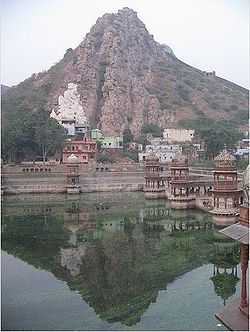Alwar
|
Alwar अलवर |
|
|---|---|
| Metropolis | |

Alwar is famous for its scenic landscape
|
|
| Coordinates: 27°20′N 76°23′E / 27.34°N 76.38°ECoordinates: 27°20′N 76°23′E / 27.34°N 76.38°E | |
| Country | India |
| State | Rajasthan |
| District | Alwar |
| Elevation | 268 m (879 ft) |
| Population (2011) | |
| • Metropolis | 315,310 |
| • Rank | 8th in Rajasthan |
| • Metro | 341,422 |
| Languages | |
| • Official | Hindi |
| • Regional | Hindi and Rajasthani |
| Time zone | IST (UTC+5:30) |
| PIN | 301001 |
| Telephone code | +91144 |
| ISO 3166 code | RJ-IN |
| Vehicle registration | RJ-02 |
| Website | http://alwar.rajasthan.gov.in/ |
| Population Growth of Alwar City | |||
|---|---|---|---|
| Census | Pop. | %± | |
| 1891 | 52,400 |
—
|
|
| 1901 | 56,700 | 8.2% | |
| 1911 | 41,300 | -27.2% | |
| 1921 | 44,800 | 8.5% | |
| 1941 | 54,100 |
—
|
|
| 1951 | 57,900 | 7.0% | |
| 1961 | 72,700 | 25.6% | |
| 1971 | 100,800 | 38.7% | |
| 1981 | 140,000 | 38.9% | |
| 1991 | 210,100 | 50.1% | |
| 2001 | 266,203 | 26.7% | |
| 2011 | 341,422 | 28.3% | |
| source: | |||
Alwar is a city and administrative headquarters of Alwar District in the Indian state of Rajasthan. It is located around 160 km south of Delhi, and about 150 km north of Jaipur, the capital of Rajasthan. Alwar is part of National Capital Region (NCR). Alwar is a part of the Ahirwal regional. It is also famous for its Olive plantation in Tinkirudi.
Alwar was formerly the capital of the princely state of Alwar which was ruled by kachwaha(Naruka) Rajputs. It was formerly spelt as "Ulwar" in British India. This placed it in last position in alphabetically ordered lists, so a king changed the spelling to "Alwar" to bring it to the top. Alwar is also known by the name "Matsya Nagar". Alwar has most haunted place Bhangarh.
Alwar dates back to 1000 AD. The king of Amer (old seat of Jaipur state) ruled the area in the eleventh century and his territory extended up to the present city of Alwar. He founded the city of Alpur in 1106 Vikrami samvat (1049 AD) after his own name which eventually became Alwar. From time to time, Different sub-clans of Rajputs ruled Alwar. Nikumbh Rajputs, Badgujar Rajputs and Last was Naruka (Kachwaha) Rajputs who took the control over this area. Marathas and Jats of Bharatpur also ruled this region for very short period. A brave Rajput Partap Singh took the Alawar Fort from Jat Raja of Bharatpur on an agreement and laid down the foundation for modern Alwar.
Great Hindu King Hemu also born into a Brahmin family in Machari (a village in Alwar) was, a Hindu emperor of North India during the 16th century, a period when the Mughals and Afghans were vying for power in the region. Hemu acceded to the throne of Delhi on 7 October 1556 after defeating Akbar's Mughal forces in the Battle of Delhi in the Tughlakabad area in Delhi, and became the de facto king. He won twenty-two battles in succession and became the last Hindu emperor of India. He is sometimes known as the Napoleon of India. He died on 5 November 1556.
...
Wikipedia

